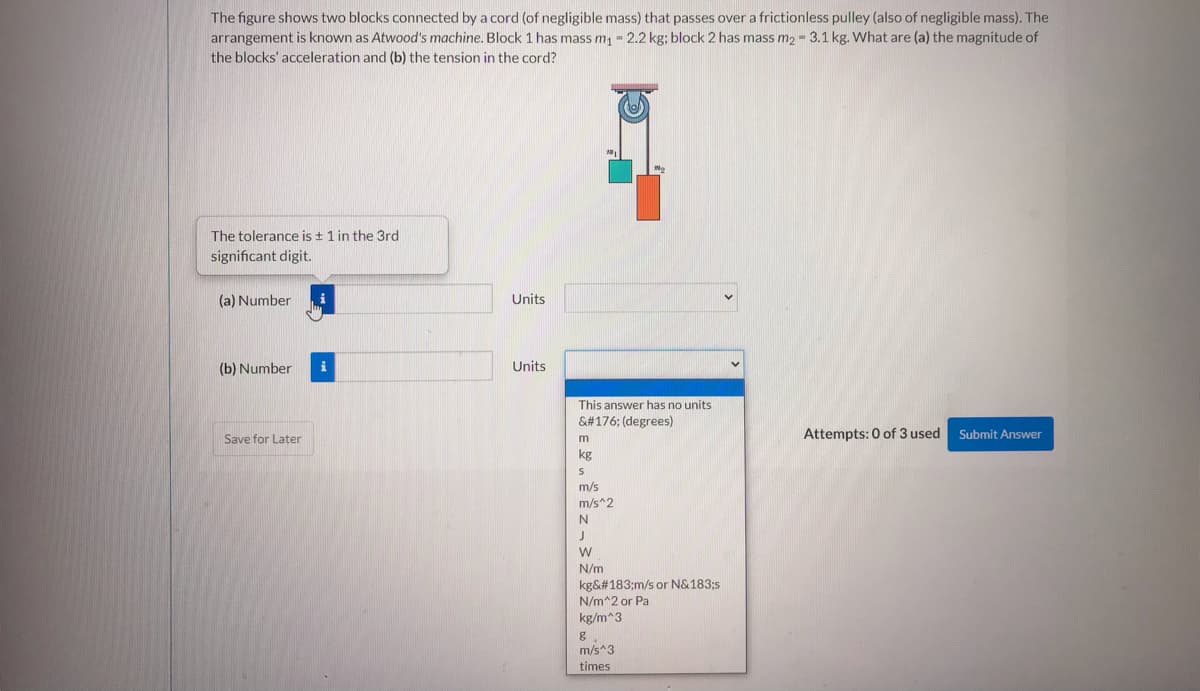The figure shows two blocks connected by a cord (of negligible mass) that passes over a frictionless pulley (also of negligible mass). The arrangement is known as Atwood's machine. Block 1 has mass m1- 2.2 kg; block 2 has mass m2 3.1 kg. What are (a) the magnitude of the blocks' acceleration and (b) the tension in the cord? The tolerance is t 1 in the 3rd significant digit. (a) Number Units (b) Number i Units This answer has no units ° (degrees) Attempts: 0 of 3 used Submit Answer Save for Later m kg m/s m/s^2 N/m kg·m/s or N&183:s N/m^2 or Pa kg/m 3 m/s*3 times
The figure shows two blocks connected by a cord (of negligible mass) that passes over a frictionless pulley (also of negligible mass). The arrangement is known as Atwood's machine. Block 1 has mass m1- 2.2 kg; block 2 has mass m2 3.1 kg. What are (a) the magnitude of the blocks' acceleration and (b) the tension in the cord? The tolerance is t 1 in the 3rd significant digit. (a) Number Units (b) Number i Units This answer has no units ° (degrees) Attempts: 0 of 3 used Submit Answer Save for Later m kg m/s m/s^2 N/m kg·m/s or N&183:s N/m^2 or Pa kg/m 3 m/s*3 times
College Physics
11th Edition
ISBN:9781305952300
Author:Raymond A. Serway, Chris Vuille
Publisher:Raymond A. Serway, Chris Vuille
Chapter1: Units, Trigonometry. And Vectors
Section: Chapter Questions
Problem 1CQ: Estimate the order of magnitude of the length, in meters, of each of the following; (a) a mouse, (b)...
Related questions
Topic Video
Question

Transcribed Image Text:The figure shows two blocks connected by a cord (of negligible mass) that passes over a frictionless pulley (also of negligible mass). The
arrangement is known as Atwood's machine. Block 1 has mass m - 2.2 kg; block 2 has mass m2 = 3.1 kg. What are (a) the magnitude of
the blocks' acceleration and (b) the tension in the cord?
The tolerance is + 1 in the 3rd
significant digit.
(a) Number
Units
(b) Number
i
Units
This answer has no units
° (degrees)
Attempts: 0 of 3 used
Submit Answer
Save for Later
kg
m/s
m/s^2
N/m
kg·m/s or N&183;s
N/m^2 or Pa
kg/m^3
m/s^3
times
Expert Solution
This question has been solved!
Explore an expertly crafted, step-by-step solution for a thorough understanding of key concepts.
Step by step
Solved in 2 steps with 2 images

Knowledge Booster
Learn more about
Need a deep-dive on the concept behind this application? Look no further. Learn more about this topic, physics and related others by exploring similar questions and additional content below.Recommended textbooks for you

College Physics
Physics
ISBN:
9781305952300
Author:
Raymond A. Serway, Chris Vuille
Publisher:
Cengage Learning

University Physics (14th Edition)
Physics
ISBN:
9780133969290
Author:
Hugh D. Young, Roger A. Freedman
Publisher:
PEARSON

Introduction To Quantum Mechanics
Physics
ISBN:
9781107189638
Author:
Griffiths, David J., Schroeter, Darrell F.
Publisher:
Cambridge University Press

College Physics
Physics
ISBN:
9781305952300
Author:
Raymond A. Serway, Chris Vuille
Publisher:
Cengage Learning

University Physics (14th Edition)
Physics
ISBN:
9780133969290
Author:
Hugh D. Young, Roger A. Freedman
Publisher:
PEARSON

Introduction To Quantum Mechanics
Physics
ISBN:
9781107189638
Author:
Griffiths, David J., Schroeter, Darrell F.
Publisher:
Cambridge University Press

Physics for Scientists and Engineers
Physics
ISBN:
9781337553278
Author:
Raymond A. Serway, John W. Jewett
Publisher:
Cengage Learning

Lecture- Tutorials for Introductory Astronomy
Physics
ISBN:
9780321820464
Author:
Edward E. Prather, Tim P. Slater, Jeff P. Adams, Gina Brissenden
Publisher:
Addison-Wesley

College Physics: A Strategic Approach (4th Editio…
Physics
ISBN:
9780134609034
Author:
Randall D. Knight (Professor Emeritus), Brian Jones, Stuart Field
Publisher:
PEARSON